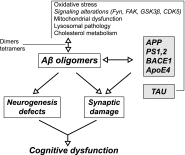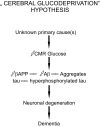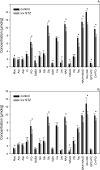Intracerebroventricular Streptozotocin Injections as a Model of Alzheimer's Disease: in Search of a Relevant Mechanism
- PMID: 25744568
- PMCID: PMC4789228
- DOI: 10.1007/s12035-015-9132-3
Intracerebroventricular Streptozotocin Injections as a Model of Alzheimer's Disease: in Search of a Relevant Mechanism
Abstract
Streptozotocin (STZ), a glucosamine-nitrosourea compound derived from soil bacteria and originally developed as an anticancer agent, in 1963 has been found to induce diabetes in experimental animals. Since then, systemic application of STZ became the most frequently studied experimental model of insulin-dependent (type 1) diabetes. The compound is selectively toxic toward insulin-producing pancreatic beta cells, which is explained as the result of its cellular uptake by the low-affinity glucose transporter 2 (GLUT2) protein located in their cell membranes. STZ cytotoxicity is mainly due to DNA alkylation which results in cellular necrosis. Besides pancreatic beta cells, STZ applied systemically damages also other organs expressing GLUT2, such as kidney and liver, whereas brain is not affected directly because blood-brain barrier lacks this transporter protein. However, single or double intracerebroventricular (icv) STZ injection(s) chronically decrease cerebral glucose uptake and produce multiple other effects that resemble molecular, pathological, and behavioral features of Alzheimer's disease (AD). Taking into consideration that glucose hypometabolism is an early and persistent sign of AD and that Alzheimer's brains present features of impaired insulin signaling, icv STZ injections are exploited by some investigators as a non-transgenic model of this disease and used for preclinical testing of pharmacological therapies for AD. While it has been assumed that icv STZ produces cerebral glucose hypometabolism and other effects directly through desensitizing brain insulin receptors, the evidence for such mechanism is poor. On the other hand, early data on insulin immunoreactivity showed intense insulin expression in the rodent brain, and the possibility of local production of insulin in the mammalian brain has never been conclusively excluded. Also, there are GLUT2-expressing cells in the brain, in particular in the circumventricular organs and hypothalamus; some of these cells may be involved in glucose sensing. Thus, icv STZ may damage brain glucose insulin producing cells and/or brain glucose sensors. Mechanistic explanation of the mode of action of icv STZ, which is currently lacking, would provide a valuable contribution to the field of animal models of Alzheimer's disease.
Keywords: Brain; Insulin producing cells; Insulin receptors; Intracerebroventricular streptozotocin injection; Non-transgenic Alzheimer’s disease model.
Figures





Similar articles
-
Rat brain glucose transporter-2, insulin receptor and glial expression are acute targets of intracerebroventricular streptozotocin: risk factors for sporadic Alzheimer's disease?J Neural Transm (Vienna). 2017 Jun;124(6):695-708. doi: 10.1007/s00702-017-1727-6. Epub 2017 May 3. J Neural Transm (Vienna). 2017. PMID: 28470423
-
Metabolic changes in rat brain following intracerebroventricular injections of streptozotocin: a model of sporadic Alzheimer's disease.Acta Neurochir Suppl. 2010;106:177-81. doi: 10.1007/978-3-211-98811-4_32. Acta Neurochir Suppl. 2010. PMID: 19812944
-
Characterization of Cerebral Damage in a Monkey Model of Alzheimer's Disease Induced by Intracerebroventricular Injection of Streptozotocin.J Alzheimers Dis. 2015;46(4):989-1005. doi: 10.3233/JAD-143222. J Alzheimers Dis. 2015. PMID: 25881906
-
Streptozotocin Intracerebroventricular-Induced Neurotoxicity and Brain Insulin Resistance: a Therapeutic Intervention for Treatment of Sporadic Alzheimer's Disease (sAD)-Like Pathology.Mol Neurobiol. 2016 Sep;53(7):4548-62. doi: 10.1007/s12035-015-9384-y. Epub 2015 Aug 23. Mol Neurobiol. 2016. PMID: 26298663 Review.
-
The mechanism underlying streptozotocin injection for the development of a nontransgenic Alzheimer's disease animal model.Open Vet J. 2025 Feb;15(2):594-600. doi: 10.5455/OVJ.2025.v15.i2.8. Epub 2025 Feb 28. Open Vet J. 2025. PMID: 40201829 Free PMC article. Review.
Cited by
-
Intranasal Insulin Attenuates the Long-Term Adverse Effects of Neonatal Hyperglycemia on the Hippocampus in Rats.Dev Neurosci. 2022;44(6):590-602. doi: 10.1159/000526627. Epub 2022 Aug 30. Dev Neurosci. 2022. PMID: 36041414 Free PMC article. Clinical Trial.
-
Effects of Creatine Supplementation on Histopathological and Biochemical Parameters in the Kidney and Pancreas of Streptozotocin-Induced Diabetic Rats.Nutrients. 2022 Jan 19;14(3):431. doi: 10.3390/nu14030431. Nutrients. 2022. PMID: 35276790 Free PMC article.
-
Chinese herbal compound Jinsiwei improves synaptic plasticity in mice with sporadic Alzheimer's disease induced by streptozotocin.J Tradit Chin Med. 2023 Feb;43(1):78-86. doi: 10.19852/j.cnki.jtcm.20220727.001. J Tradit Chin Med. 2023. PMID: 36639998 Free PMC article.
-
Ebselen reversed peripheral oxidative stress induced by a mouse model of sporadic Alzheimer's disease.Mol Biol Rep. 2020 Mar;47(3):2205-2215. doi: 10.1007/s11033-020-05326-5. Epub 2020 Feb 24. Mol Biol Rep. 2020. PMID: 32095983
-
Protective effects of evodiamine in experimental paradigm of Alzheimer's disease.Cogn Neurodyn. 2018 Jun;12(3):303-313. doi: 10.1007/s11571-017-9471-z. Epub 2018 Jan 25. Cogn Neurodyn. 2018. PMID: 29765479 Free PMC article.
References
-
- Hau J. Animal models of human diseases. In: Conn PM, editor. An overview. (in:) Sourcebook of Models for Biomedical Research. Totowa: Humana Press; 2008. pp. 15–20.
-
- Bertram L, Tanzi RE. The genetics of Alzheimer's disease. Prog Mol Biol Transl Sci. 2012;107:79–100. - PubMed
-
- Games D, Adams D, Alessandrini R, Barbour R, Berthelette P, Blackwell C, Carr T, Clemens J, et al. Alzheimer-type neuropathology in transgenic mice overexpressing V717F beta-amyloid precursor protein. Nature. 1995;373:523–527. - PubMed
-
- Li C, Ebrahimi A, Schluesener H. Drug pipeline in neurodegeneration based on transgenic mice models of Alzheimer's disease. Ageing Res Rev. 2013;12:116–140. - PubMed
Publication types
MeSH terms
Substances
LinkOut - more resources
Full Text Sources
Other Literature Sources
Medical

